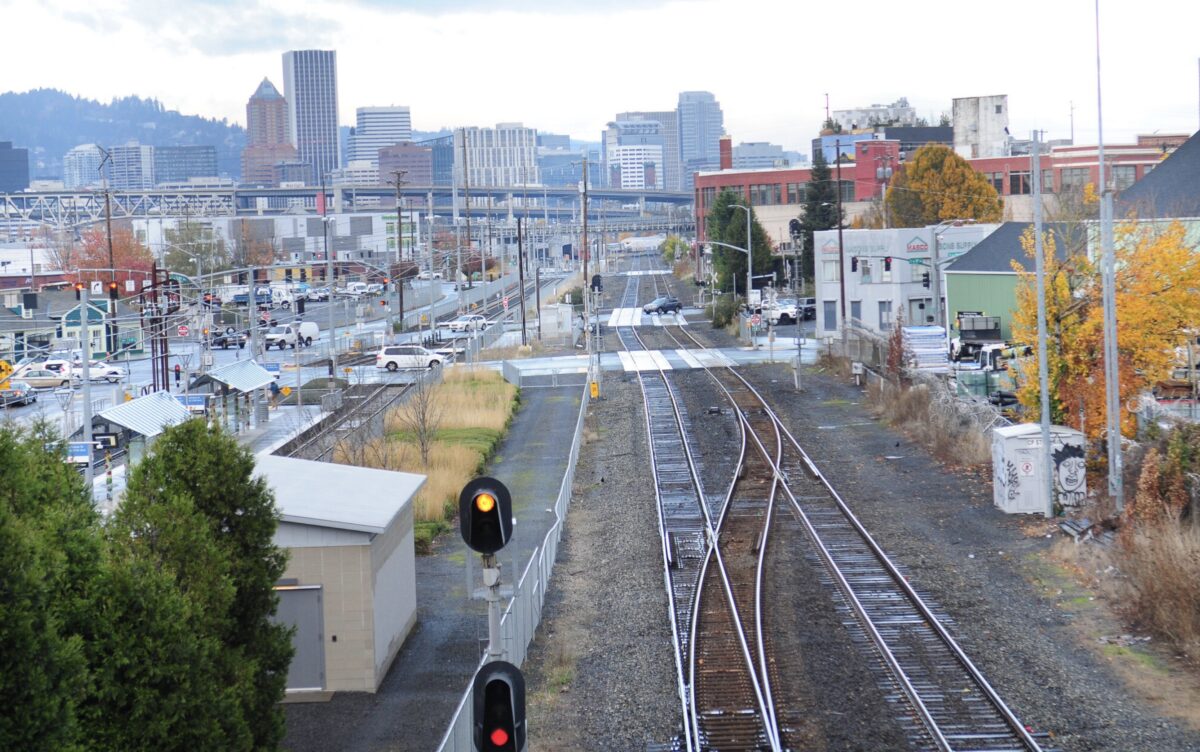
People are fed up with being at the mercy of Union Pacific trains that rumble through inner southeast Portland every day. The trains create an impenetrable barrier (unless you risk hopping through them) and long traffic delays that have frustrated locals and everyone who uses nearby roads and bike paths for many years. Now, thanks to a new federal grant program with funding to mitigate the impacts of problematic railroad crossings, something might finally give.
The problem
How big of a deal is this? This summer a Brooklyn neighborhood advocate led a Pedalpalooza ride and published a website about it to share tips on how to avoid it.
The tracks come into Portland from the southeast via Brooklyn Yard and follow SE McLoughlin Blvd up to SE 17th Ave, then line up with the Willamette River’s eastern bank until they veer north up to Vancouver (or vice versa). The portion of the tracks north of Powell Blvd and south of Stark St causes the most disruptions, with frequent blockages for people trying to go north-south through the area. Recently, the problem has worsened because of changes in Union Pacific operations to increase train lengths, making it much more difficult to get around them.
This area also lines up with heavily-used bikeways and obstructs what would otherwise be some of the smoothest bike routes in the city. For example, you might have an uninterrupted ride west on the Clinton Street greenway toward the Tilikum Crossing before having to stop at the tracks. People traveling from south of the tracks might have easier access to the Tilikum, but they suffer the same fate when trying to go north.
While people biking and walking have more options for crossing the tracks compared to someone stuck in their car these options aren’t always available. Most notably, the Bob Stacey Overcrossing elevators over the tracks at SE 14th are notoriously unreliable, making it impossible to use for people who can’t climb the stairs and/or lift their bikes up them.
People using public transit suffer as well. I’ve watched the MAX orange line train depart from the Clinton and SE 12th Ave station without me because of an unrelenting freight train, and passengers on the TriMet bus lines that run through the area are stuck in the same situation as people in cars. And TriMet’s $175 million Division Transit Project to bring faster bus service to the Division corridor opens next month on a route that will use the Tilikum Crossing to travel from inner southeast to the south waterfront. Major train-related blockages are incompatible with an “express” bus route.
“The train blockages encourage unsafe behavior. Drivers might try to beat the gates if they see a train might be sitting there for a long time, and people walking and biking will sometimes hop the trains, which is really unsafe. We have a high level of community concern [about this].”
-Zef Wagner, PBOT
The advocacy
Last year, members of the Central Eastside Industrial Council and Hosford Abernethy and Brooklyn Neighborhood groups put together a Change.org petition asking the Portland Bureau of Transportation to address the frequent train blockages, saying railroad intersections in this area “need major improvements to keep the roads safe for all and easy to commute, and address concerns of increased carbon emissions.”
In the comments section of the Change.org petition, people recounted their experiences waiting at the train tracks with real emotion and said it hurts local businesses and impacts where people decide to live.
“I moved to SE Portland thinking it was a reasonable commute from work. That was because I had been lucky enough to avoid the train the first couple times I visited. Now I plan pretty much every trip around avoiding this train, which adds time driving longer routes or through construction zones. It’s ridiculous. Can’t wait to move out of this area for this reason.” one commenter said.
“This regularly impacts my travel and more recently I am just avoiding this area and nearby businesses altogether due to chance of being stuck behind trains,” another person wrote.
Mobility in the central eastside is on a roll right now with the Oregon Museum of Science and Industry District plan, the new Blumenauer Bridge, and renewed interest in the Green Loop. Unpredictable and long heavy rail crossings could pull the brakes on all that momentum.
The solution?
At Tuesday night’s City of Portland Pedestrian Advisory Committee (PAC) meeting, PBOT planner Zef Wagner said the city hears these concerns and are working to tackle the problem – or at least start to figure out how.
The federal Infrastructure Investment and Jobs Act passed last year includes a grant program for railroad crossing elimination projects across the country, providing funding for “highway-rail or pathway-rail grade crossing improvement projects that focus on improving the safety and mobility of people and goods.” This is a $600 million national competitive grant program with $18 million allocated to planning studies, which PBOT wants to snag $1 million of to conduct the Central Eastside Railroad Crossing Elimination Study.
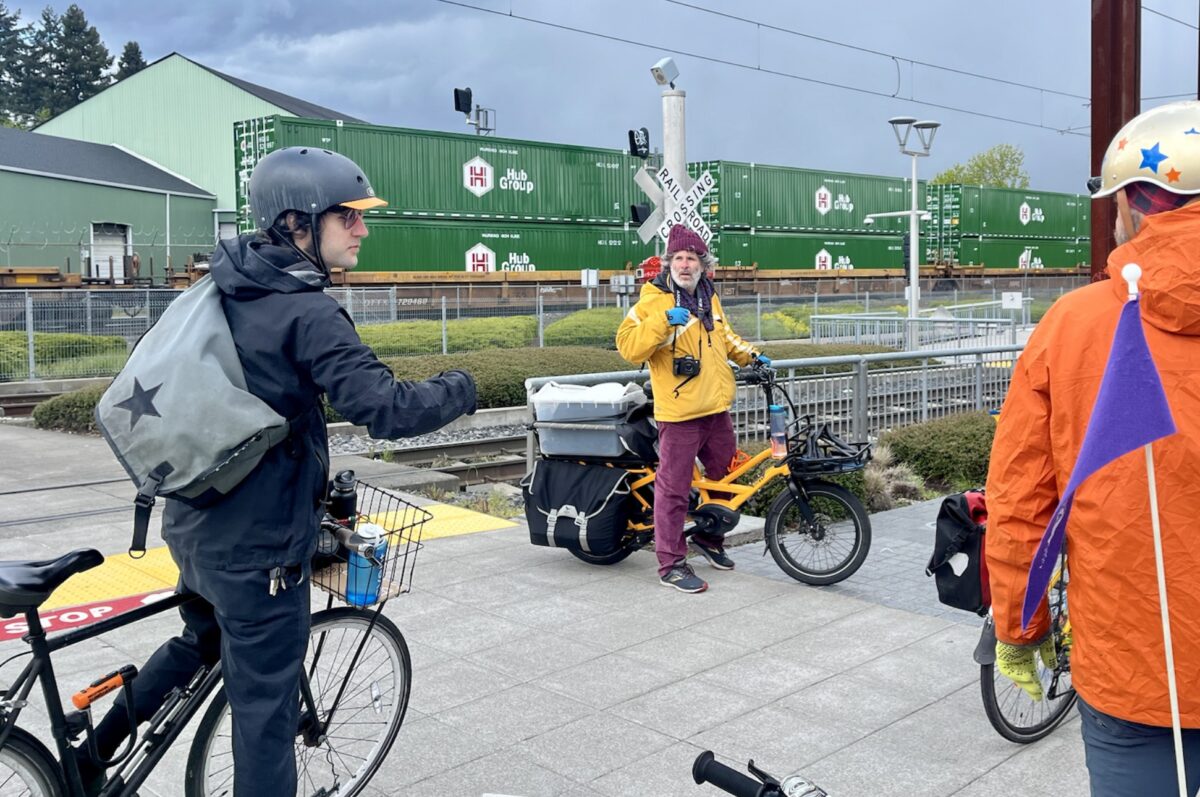
“We think this would be really competitive for this program, because those train blockages encourage unsafe behavior. Drivers might try to beat the gates if they see a train might be sitting there for a long time, and people walking and biking will sometimes hop the trains, which is really unsafe,” Wagner said at the meeting. “And we have a high level of community concern [about this].”
With this study, PBOT would look at the feasibility of more grade-separated crossings or undercrossings, as well as potential non-infrastructure solutions like wayfinding to give people information ahead of time about when trains are coming. Grant applications are due in early October, and Wagner asked the Bicycle and Pedestrian Advisory Committees to consider writing letters of support for the project.
Brooklyn neighborhood advocate and self-appointed train track crossing educator Josh Hetrick has advocated for more access across the train tracks. He said he sympathizes with people aggravated by this problem and has felt it himself, too.
“When long blockages occur, there are tons of cars idling. Our neighborhood already has some of the worst air quality in the city (due to highways, the rail yard, heavy freight traffic, a TriMet garage, and other industrial sites) and idling emissions just compound that,” Hetrick told me. “It’s just one more thing to deal with each time you leave the house and need to cross the tracks. You don’t have to wonder ‘Can I use the road today?’ with most other roads.”



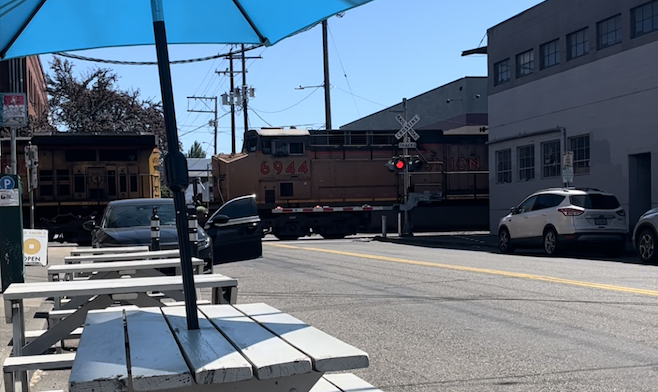
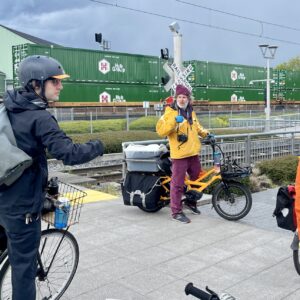
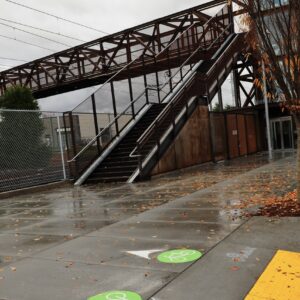
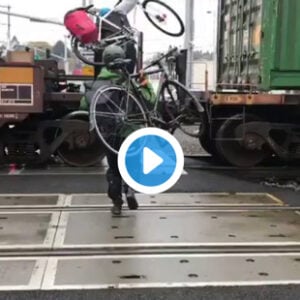
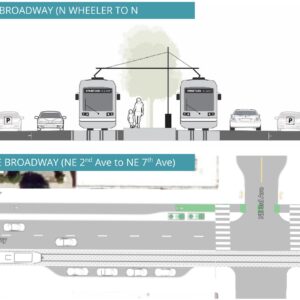
Thanks for reading.
BikePortland has served this community with independent community journalism since 2005. We rely on subscriptions from readers like you to survive. Your financial support is vital in keeping this valuable resource alive and well.
Please subscribe today to strengthen and expand our work.
Good to hear that people are looking at mitigating the impact of the trains. It would be ideal if remediating the trains, realigning Water Street, and other transportation infrastructure projects would invite a reevaluation of the bike infrastructure connecting the Tillicum Crossing, Springwater, and Clinton east of 12th. These assets should be connected by safe, inviting infrastructure that can be navigated by commuters moving fluidly in both directions at a reasonable speed and are well supported by wayfinding.
Right on Jim! The multiuse path infrastructure design in this area is flawed and connections to major bikeways are quite awkward. I have yet to figure out the “correct” way to transition from the path to SE Clinton – it’s unclear where to cross 12th.
are they saying that the more people that illegally cross the better the chances are for grant funding?
While this seems like a very good idea for a project, I have no idea where they would go with these rail lines or roads. Raising or lowering the rail would be wild with the Brooklyn yard being so close, there is only about 2,000 feet to work with from the yard to Clinton area with multiple bridges involved. I think they’d have to go down since Powell is an overpass already.
Road elevation also seems incredibly difficult, flyovers at 11th and 12th would involve bridges that extend to or past Division and Powell. Its possible we could create a local neighborhood under the passes.
The most reasonable solution seems to be lowering the rail by a moderate height to make the road bridges a more feasible length, but I can’t imagine the rail companies wanting to create any undue friction in their routes.
I think there was a plausible design proposed for an overpass connecting around SE 7th & Division, since that’s already elevated relative to the other side of the tracks. It wouldn’t be trivial but it’s probably the most realistic option of the bunch.
What they should have done was to have the Tilikum extend over the tracks. Perhaps it’s not too late to make that happen.
My memory is the Tilikum project (which was much bigger in scope than just the bridge itself) included serious discussion of dealing with all the at grade crossings. When I heard that a good chunk of federal dollars were returned unused, this is what I thought of, while waiting for a train.
It’s absolutely incredible to me that the decision was made to route the Division Transit Project over the Tilikum (and therefore over the train tracks). The marginal speed benefits from the project will be completely destroyed by how unreliable this bus journey will be.
Yeah I’ve been skeptical of that choice since day 1, and blockages at 8th Ave have only gotten more frequent as the trains have gotten longer. TriMet has been rather squirrelly about sharing specific detour plans, and I’ve been asking throughout the project.
That said, I’ve seen some proposed detour routes that use the MLK/Grand viaducts. They do look circuitous on paper but (fingers crossed) don’t look too bad in terms of actual time delay. But none of the MAX lines have a known failure point like this, so I don’t see why this particular high-capacity, frequent transit line should have one just because it’s not fixed rail. We’ll see how it plays out.
TriMet may not have realized how the UPRR’s operations are changing to make the crossing issue worse. Though informed community members alerted them to the issue during community meetings, TriMet (like PBOT) has come to see community engagement as a one-way push of information, and the agency simply didn’t listen.
“We’re buying UPRR some expensive switching equipment that will fix the problem, please don’t tell us why it won’t work.” was the standard response. It didn’t work.
Perhaps this problem could have been avoided if TriMet saw residents as partners rather than subjects.
I mean, isn’t that how MAX was born? Listening to the neighbors? Too bad TriMet got such a big head from the early successes of MAX. Shame we have such a terrible transit manager. Our region could be so much better if TriMet wasn’t so terrible at its job.
I’ve e-mailed TriMet twice on this very topic. Both times before plans were finalized. I cross these tracks (pedestrian) twice a day, every day I work. I call if the train is not moving. My phone shows I call between two and eight times a month. This on a four day work week basis, so eight crossings a week usually.
My record wait (after MAX went in & before the return of a pedestrian overpass) was one hour and 50 minutes. And traffic was already stopped & backed up in front of my workplace more than three blocks north of the crossing when I left work.
It is not so much the trains moving through that are a problem, though UP has pretty much doubled the length of the longest making even a moving train a non-trivial wait. It is the ones the park on the tracks. UP is using SE Portland and likely NE, NW, N PDX (and probably Milwaukie) as an extension of Brooklyn Yard.
UP logistics appears congenitally unable to manage trains in Brooklyn Yard without disrupting neighborhoods and transit throughout the Metro area. Perhaps it is time for UP to dismantle Brooklyn (better: turn it over to the Rail Historical Society) and move switching out somewhere into empty countryside. There, they can park the trains for extended periods without blocking multiple crossings & polluting multiple neighborhoods.
Relocation would be enormously expensive. I’m sure they were consider it if sufficiently compensated.
Maybe they are hoping that if they have a lot riding on getting this funding, then they will be more likely to get it.
There have been some talks to relocate the Brooklyn and Albina railyard out of Portland! My fantasy is for federal reform or the railroad system in the US led by Biden/Buttigieg. Of course, I have no idea if that is possible, but this seems like the bet shot we had in decades to compel the railroads to accomodate passenger rail shedules, to invest in highspeed and passenger routes, and introduce more accountability to work with city and state govenments to accomodate local transportation needs.
Repurposing the Brooklyn Yards to residential could go a long way in solving the housing crisis. Excellent transit connections there could make it a low car use neighborhood. A big rail yard in Canby near the airport and I-5 could be a convenient transportation hub and get heavy truck traffic out of inner SE. The RR could turn a sweet profit developing the land.
The UPRR is not a developer and they already have the infrastructure they want/need along with advantageous rules that allow them to operate how they want. So, the city/feds would have to pay to relocate their yards and tracks to other locations. If they pursued this path, to recoup the cost, the last thing getting built on the Brooklyn yards would be affordable housing, it would likely look like the redevelopment of yards in Denver which is predominantly high end condos, townhouses and apartments.
You can force them in the zoning to build some of it for affordable housing.
But you can’t force them to build, so that might be why affordability requirements baked into the Zoning code have not exactly supplied us with huge volumes of affordable housing.
the railroad is God in the U.S.
Second only to the shipping industry. It’s impossible to work with either of them.
Yeah, that RRs care little for the public good and do not “play “ well with others is known. Throwing ideas at them with win, win, win outcomes may display my Pollyanna optimism that things can be better. Reading comments on the BP keeps that in check
I remember a story from maybe 2014 of some guy who got fed up with the crossing at SE 12th and called UP to gripe
Apparently he talked to them for like an hour, and they said they were open to the idea of moving their yards if the economics could be made to work.
When I lived in Portland I was always surprised that there were so many level railroad crossings – it was very quaint, one of those things that made Portland weird. I see the same thing in Durham & Raleigh NC, as well as in Salem & Eugene Oregon.
But in Spokane, Chicago, Charlotte, and here in Greensboro NC, all the tracks are raised well above street height, like they do it in London and most European cities, with frequent underpasses and very rare level crossings (there always has to be one for moving hazardous materials by truck). I’m curious, why didn’t Portland raise all their tracks before 1950 when so many other cities were doing it?
great. can’t wait for this grant to pay for a study to confirm that the trains are impactful. the only thing that moves slower than the city is the feds.
Thank you to the neighborhood associations who have doggedly pursued getting this issue fixed (and helped get the Bob Stacey bridge built)! You’re all community volunteers and I appreciate your efforts!
Big missed opportunity when the streetcar bridge going over the tracks to OMSI and Tilikum was not built to accommodate bikes and peds.
I will NEVER understand why they didn’t do that. It was such an obvious choice.
I believe the grade is too steep; I’m pretty sure it was considered
Underpasses seem like a great idea. I never understood why Portland only thinks about going over rail lines, never under. Boulder Colorado has an elaborate system of underpasses as part of their bike network that work great
Take a walk/ride along Powell under the underpass at 17th and maybe you’ll understand. I don’t know anyone who will use that facility any more, even when avoiding it requires substantial effort.
And mind you, this is after the underpass was “upgraded” during the Orange Line construction.
I just looked at it on google maps, yeah that looks pretty bad
Here are some ways to cross the train tracks on your bike
https://youtu.be/XjQ3eIExCRE
I hope the solution they come up with will be short bridges over the train tracks with no ramps and an elevator at either end that is large enough to raise or lower a car. I also hope that the elevators are out of commission about %60 of the time.
It would be even better if they could make sure the overhead lighting is broken for enhanced nighttime use, and maybe someone could set up a tent in one of the elevators and yell at anyone who dares try to use it.
I like the way this is going. Smear some feces all over the walls and you’ve got yourself a deal!
I’d love to see a study comparing the potential congestion reduction and costs of removing the at-grade crossings vs the same metrics for the new I-5 bridge. It’d be expensive to bury the tracks or build under/overpasses, or even move the railyard, but it is it interstate river bridge kind of money?
simple..limit the length of the train..such that it actually fits in the train yard.
8000ft train max..they can fit and build the train cars to this length within train yards.
That is the logical solution. Unfortunately, just like water rights in the USA, the legal structure around railroads is completely nonsensical and illogical. In the 19th century, the federal government gave away vast tracts of land for free to anyone who built a railroad in order to incentivize railroad construction. The feds basically allowed railroad tycoons to run their empires like private kingdoms with zero oversight. In other countries, railroads were nationalized or run as public/private corporations, but not here. The feds have never tried to wrest back any meaningful regulatory authority from the railroads, so they can essentially do whatever they want within their rail right of way.
“Oh, I’m sorry, is my train blocking the road and delaying thousands of people who are trying to drive home from work? Too bad, the tracks were here first, and you can’t do anything legally to force me to move it. Why don’t you build your roads at a separate grade or pay millions of dollars to realign or upgrade my tracks that I own? If you don’t want to do that, I’ll just block your roads. Oh yeah, and I’ll burn some nasty low grade diesel fuel and avoid adding emissions controls to my locomotives. Hope that’s not a problem. And I’ll let you run passenger rail on my tracks, but I might decide to wreck your train schedule and delay your trains by hours or even days. Those Walmart containers need to get to their destination, and Walmart runs many more trains than Amtrak does.”
This isn’t entirely true; UPRR would argue that they were here first, and it’s not their fault people built a city around them. That seems as persuasive as those who argue that if you rent an apartment above a bar, you have no right to complain about the noise.
The RRs own and maintain their tracks, and it’s not unreasonable for them to decide how to use them. Do you want the government to just take them? If Amtrak wants priority, they could pay for it.
You mentioned emissions: how you would compare the emissions produced by railroads with what would be emitted if an equivalent amount of freight moved by truck? And would you want to share the roads with that many more large, heavy vehicles?
I’m no lover of the train companies, and I agree that the rules do not serve the public well in some important ways, but they’re not totally arbitrary and random, and getting rid of them would be challenging.
I think the issue deserves a bit more nuance than your post contains.
Should the government just take the tracks?
Probably not. But I don’t think the land should have been given away, more or less, in the first place. So maybe?
There should definitely be some regulation and compromise around the management of grade crossings. I mean, extended blockages should never happen during peak commuting hours. Whether that means the railroad should run shorter trains, reconfigure their railyard, upgrade their switching infrastructure, or adjust their scheduling, it doesn’t really matter to me. But it shouldn’t happen. Yes, Portland (or the federal government) could spend billions to reengineer the crossings to eliminate conflicts, but I doubt that’s the most efficient solution (or maybe it is, and I’m willing to be convinced otherwise. But the way things run now, the railroads just get priority and no consideration is given to anything else or anyone else).
What about emissions?
Yes, on average and in aggregate, it is much more fuel, space, and labor efficient to move things by rail rather than truck (barges are even better, btw). But railroads are not required to abide by cafe standard type regulations or emissions regulations that apply to highway vehicles. They could do things like run over head wire electrified, non diesel trains in urban areas to avoid the alarmingly high pollution levels that are typical of rail yards, but they don’t. Now diesel trucks are allowed to get away with way more pollution than they should (especially in Oregon). And they too are highly problematic. But there are ways that train related pollution could be reduced that aren’t being required by federal regulations. I used to go past the rail yard along St Helens on the regular, and many of the locomotives were clearly in a poor state of maintenance, and were belching massive black clouds. It’s illegal for cars and trucks to do that (though rarely enforced). It should be possible to prevent the railroads from doing it as well.
Perhaps not, but at the time the national context was VERY different than it is today*. At the time, the decision made more sense. Undoing it now would be nearly impossible (or astronomically expensive).
Changing railyard operations as you suggested is going to cost money, especially if it requires the RRs to operate less efficiently (with more manpower/equipment required to move a given amount of freight). Getting them to adopt those restrictions might simply be a matter of paying them to offset those costs.
I’m well aware of the diesel particulate pollution emitted by diesel engines (and as someone living in the neighborhood of a major rail yard, the issue is hardly academic to me). Electrifying would be a huge endeavor, but we could probably get 70% of the benefit by electrifying just the yard and the switching engines. Or, if particulates are the problem, installing filters would probably be cheaper. All of this is simply a matter of money, and if it’s going to happen, someone is going to have to decide whether it’s easier to have the public pay for it, or expend the energy fighting about it. These are political calculations I am not prepared to make.
But it’s worth considering that a lot of the pollution associated with rail yards _is_ truck traffic; local freight trucks are some of the most polluting vehicles on the road, and addressing those vehicles would help the pollution problem considerably, and would involve poking at a much smaller hornet nest.
*I know the trend amongst the youngsters is to judge actions/attitudes of the past by the standards of today; if this persists, today’s meat eaters, especially bacon lovers, should prepare to be held to account for mass industrial slaughter, and shrimp eaters to be held to account for supporting the widespread slavery that taints much cheap shrimp (and probably other seafood). Good luck!
It’s very hard to say when Portland was first settled by white people – records from before 1850 are hard to come by. It’s far more likely the city was named around 1809 after the same fellow as the city in Maine, the prime minister when we got our independence in October 1783, rather than later named by a pair of egotistical drunken ship captains from Maine named Ankeny and Lovejoy who quite naturally would make such a boast without witnesses nor a written record. Up until 1846 Oregon was jointly owned by both the USA and the UK, so a British name origin is just as likely as an American one. The railroads rights-of-way came before statehood in 1858, probably in the 1840s sometime, likely in 1849 during the California gold rush. In the 1800s railroads were seen as a progressive high-tech industry, something every community badly wanted, and you can bet that Portland was eager for UP and Northern Pacific (BNSF) when it was offered. You can be equally certain that UP and BNSF are quite proud of having developed the port of Portland and much of the city around them.
I think it is fairly well documented that Fort Vancouver, 1825, was the first British settlement in the area. I’ve not seen them myself, but my understanding is that there are fairly extensive records of the Hudson Bay Company and their activities in the Pacific Northwest.
The first railroad was on the east side of the Willamette in 1869.
Lewis & Clark visited a trading post in Vancouver in 1805 or 1806, run by the same Dr. McLaughlin of Captain Vancouver’s expedition of 1792 – did it constitute a “town” back then or not? The Hudson Bay Company records office is in Winnipeg Manitoba and it is extensive, with records dating back to 1670. I agree, it would be interesting to see what they recorded about the Pacific Northwest and how certain places got their names and when they were settled, as would the Admiralty at Whitehall in London. The origin of “Oregon” is still a controversial mystery.
That would require an act of Congress at this point.
There is nothing to ‘study’. What’s needed is called a ‘grade elimination’; every traffic engineer knows what that is.
Easier said than done. Take a look at the $100 million Lander overpass in Seattle, and try to imagine doing that to every street in this area. How would that even work?
https://www.seattle.gov/transportation/projects-and-programs/programs/bridges-stairs-and-other-structures/bridges/lander-st-bridge
These big, heavy viaducts create walls and barriers, and break up the fabric of the city in ways that I find destructive.
The best “magic wand” solution for the CEID is probably putting the RR in a trench, but that would be enormously difficult as you need to keep the trains running during the several years of construction, and the Orange Line now occupies the best location for a temporary detour. And once you get into the CEID, where would it go?
Maybe if we elect a city council from multi-member districts, they’ll be able to figure this out.
I’ve seen some train viaducts that have shops underneath that I thought were both charming and a pretty good use of space.
While we’re at it why don’t they just build tunnels for I-5?
BUT, train problems are worse at SE 11th/12th Xings than in the CEID, and if you just start there that’s a smaller and easier problem to solve.
Plus, maybe they should put the train overhead and leave ground level for the peoples?
That’s what NYS with many inner city LIRR routes. And, like bike infra, trains work best with minimal intersections and cross traffic to negotiate.
I’d like to see a Green Loop foot/bicycle crossing from SE 6th and Grant to SE Tilikum Way. It might be possible to do it without elevators; I’m thinking of the pedestrian bridge at Hollywood Transit Center as a model.
TriMet should look into a Caruthers bus/bike bridge running from SE 6th to SE 9th for the new Division FX line.
TriMet or the City should also build an elevator-free overcrossing at the Clinton Street MAX station. I imagine a ramp starting at the south end of the MAX station climbing to 12th, crossing at 12th, and then descending to Milwaukie Avenue (or to 13th and Clinton, if they get rid of the parking lane on the south side of Clinton). Put the east stairway at 12th and Clinton, and the west stairway at 12th and Gideon.
Dang, there’s a lot of talk about the effect this problem has on car trips, but very little about cycling, How about this idea? Figure out a way to make “The Bob” a safe and convenient crossing the the way it was designed to do?
Hey, Joanne Hardesty, the election is right around the corner.
Here’s a chance for a photo-op custom made for someone who may or may not have a job on November 9.
The 1998 bond issue for “South/North” MAX included an underpass for 11th/12th Avenues. Unfortunately, it was narrowly voted down by the region, so we got the low cost version…Interstate MAX, the Green line and then finally the Orange line, but no underpass, at least not yet!
It’ll cost billions and the city will have to pay for it. Fuggetabaudit.
P.S. How about that new Chinese train that runs on an overhead electromagnetic monorail without actually contacting it. Cheap to build and operate which is why America won’t be interested.
Great article, Taylor! I’d love to see PBOT get the funding and hope eventually to see them implement solutions for active and public transport, but not cars. Barriers like trains and rivers are excellent opportunities to make biking *more* convenient than car travel.
I live literally blocks from the 12th and clinton crossing. I bike, drive and walk to get to points all over this town and I have only once found myself inconvenienced here.
Driving – just don’t if you can, but if I must I just don’t put myself in a position to use 11th or 12th between Powell and division (if south on 11th and I see brakes, I go back to Hawthorne – don’t cut through ladds speed-racer!)
walking and Biking – the 14th crossing, the powell tunnel, and grand ave are all great choices, but admittedly are frequently dirty, tight spaces, or broken elevators.
So yea. If the city and trimet put a hard focus on KEEP THESE PATHWAYS clear, working, well lit and safe, we’d have a bit less to complain about with the train. The solutions exist, they are just unfavorable. I’ll bike under the powell tunnel solo on my road bike or commuter, but I wont go with the cargo ebike and/or a kid in tow or following.
But really, to move next to a train track and complain about the train track is sort of ridiculous. NIMNBY (Not In My New BackYard) is sort of foolish when the reason the trains are longer and more full is from the same influx of people, construction and car purchases.
I am Chris and thanks for attending my TED talk
The train tracks should immediately pitch down after the Powell viaduct. At a 1-1.5% grade (which google says is all freight can handle?) they could be under ground by 99E. The train needs to be in a cut and cover trench along the whole inner east side. Plus we could likely get away with smaller overpasses at 8th, and water. It would also open up the inner Eastside to additional density improvements.
The reality is that there are no warehouses in the inner Eastside still taking delivery by rail, which is why it was surface run, similar to the lines through Sodo in Seattle. Getting them out of the way would greatly improve the quality of life in the neighborhood and allow new development in an area already well connected to the city.
If money was no object I’d vote we sink the whole Brooklyn yard by a few (5-10) feet and rebuild the Powell crossing to completely solve the issues at 11/12 and be underground by 8th.